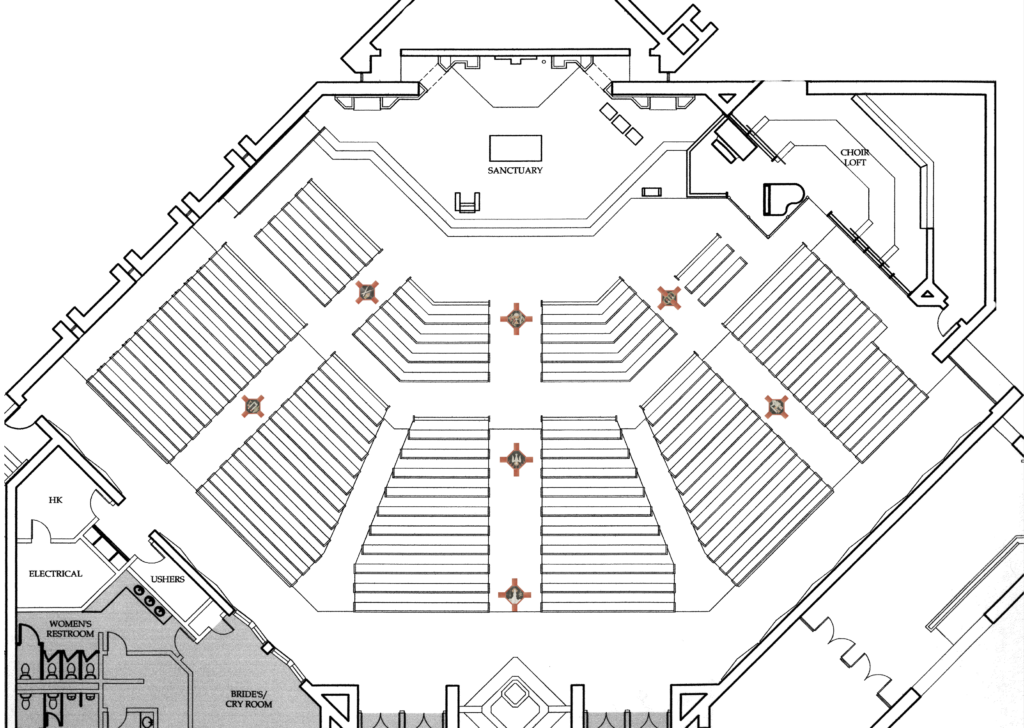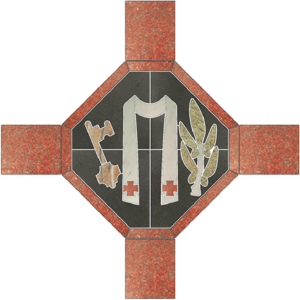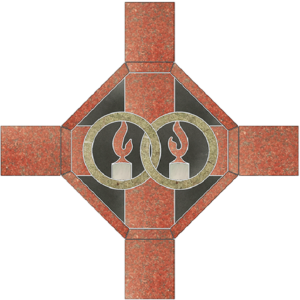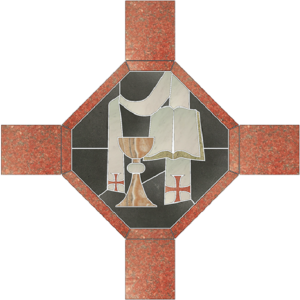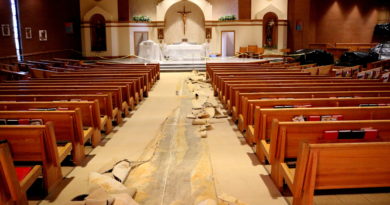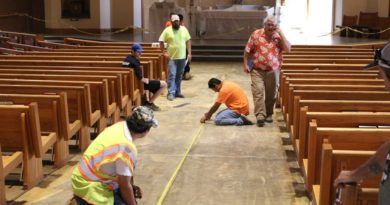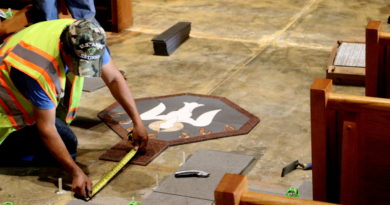What is the symbolism of our mosaics?
About the Marble Tile Mosaics
Shape and color: each of the mosaics is meant to be connected to our baptismal font in shape and color. Many baptismal fonts are eight-sided representing the Eighth Day—the work of God’s New Creation. The book of Genesis recounts that God created the universe in six days and on the seventh, the Sabbath, He rested. His work of new creation came about through the passion, death and resurrection of Jesus Christ, whose rising took place on the day after the Sabbath, the eighth day. Now that Christ has risen from the dead, we live in the age of the New Creation, the Eighth Day.
Our baptismal font is red granite and eight-sided (symbolizing new creation) with an inset cross (symbolizing Christ overcoming sin and death through His passion, death and resurrection). Each of the medallions, depicting one of the sacraments, is the same basic shape of the baptismal font surrounded by red granite. The Christian life begins with Baptism which is also the entryway to the rest of the sacraments and thus, the intentional connection with our Baptismal font.
Location of the mosaics
Sacraments of Initiation:
The Baptismal font is on a direct axis with the altar in the sanctuary. The three sacraments depicting Christian initiation (Baptism, Confirmation and Eucharist) flow from the Baptismal font at the entrance of the church, down the central nave to the altar, the place of Eucharistic celebration. Because of their centrality in the life of the Christian, the Sacraments of Initiation have been placed in the central nave.
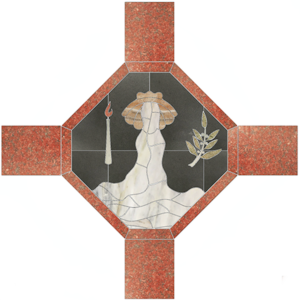 The Baptism mosaic contains many rich symbols. The water flows from a shell or scallop, an ancient symbol of eternal life. Pilgrims often walked along the shore and kept shells as keepsakes from their journey. The shell’s umbo or hinge has three parts, representing the three times water is poured (In the name of the Father, and of the Son, and of the Holy Spirit). The shell has seven segments in its outer lip, each of which represent the seven sacraments.
The Baptism mosaic contains many rich symbols. The water flows from a shell or scallop, an ancient symbol of eternal life. Pilgrims often walked along the shore and kept shells as keepsakes from their journey. The shell’s umbo or hinge has three parts, representing the three times water is poured (In the name of the Father, and of the Son, and of the Holy Spirit). The shell has seven segments in its outer lip, each of which represent the seven sacraments.
The lit candle depicts a Baptismal candle, itself a reminder of the Pascal Candle which brings light to a darkened church as Christ cast light upon the world when He rose from the dead.
Noah’s dove brought him an olive leaf – a sign that the Great Flood was ending. The purifying waters receding from the earth foretell the joy of the receding waters of Baptism.
 The Confirmation mosaic depicts a descending dove and seven tongues of flame. The dove flying downward is a direct reference to the Baptism of Jesus in Saint Mark’s Gospel and shows the relationship between the sacraments of Baptism and Confirmation.
The Confirmation mosaic depicts a descending dove and seven tongues of flame. The dove flying downward is a direct reference to the Baptism of Jesus in Saint Mark’s Gospel and shows the relationship between the sacraments of Baptism and Confirmation.
The seven flames represent the seven Gifts of the Holy Spirit: wisdom, understanding, counsel, fortitude, knowledge, piety, and fear of the Lord.
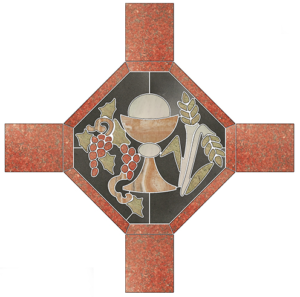 The Eucharist mosaic is closest to the altar. Wheat and grapes are turned into bread and wine through our work, and then into the Body & Blood of Christ by the work of the Holy Spirit. All the materials are gorgeous marble and stone.
The Eucharist mosaic is closest to the altar. Wheat and grapes are turned into bread and wine through our work, and then into the Body & Blood of Christ by the work of the Holy Spirit. All the materials are gorgeous marble and stone.
Sacraments of Healing:
The aisle flanking the west side of the nave depicts two other sacraments given in the life of the Church. Through the sacraments of Christian initiation, we receive new life in Christ. Now we carry this life “in earthen vessels,” subject to suffering, illness, and death. This new life as a child of God can be weakened and even lost by sin. The Lord Jesus Christ, physician of our souls and bodies, has willed that the Church continue His work of healing and salvation. This is the purpose of the two sacraments of healing: the sacrament of Penance and the sacrament of Anointing of the Sick.
The Penance or Reconciliation mosaic contains three symbols of forgiveness and healing. The priest’s stole is a visible symbol of his priesthood. Hearing confessions is a principal element of priestly ministry.
While the papal coat of arms displays two keys, a single key is an additional reminder that a priest’s power to forgive sins comes directly from Jesus Christ. The two keys on the papal insignia recall Saint Matthew’s Gospel, “what you bind on earth shall be bound in heaven, and whatever you loose on earth shall be loosed in heaven.”
The third symbol is a hyssop plant, a sturdy plant that the Israelites used to paint blood on their doors during their Exodus from Egypt, and mentioned in the Psalmist’s prayer, “Cleanse me with hyssop, and I will be clean.”
The Anointing of the Sick mosaic is adorned with two lit candles and a jar of oil.
The two lit candles are part of an old tradition that involves a priest visiting a sick person’s home. One lit candle stays near the sick person and the other is held by someone greeting the priest who is likely carrying the Blessed Sacrament.
The jar of oil contains the Oil of the Infirm, hence the initials O.I. The Oil of the Infirm is blessed by a bishop in his cathedral during Holy Week and used by parish priests throughout the year to anoint the sick. Containers of this healing oil are traditionally kept in parish churches.
Sacraments of Vocation:
The aisle flanking the east side of the nave depicts the two sacraments of Vocation, Marriage and Holy Orders. While the sacraments of Christian initiation ground us in our common vocation to holiness and to the mission of evangelizing the world, two other sacraments, Holy Orders and Matrimony, are directed outward towards the salvation of others; if they contribute as well to personal salvation, it is through service to others that they do so. They confer a particular mission in the Church and serve to build up the People of God.
The Matrimony mosaic shows two lit candles and two rings. These candles represent the husband’s and the wife’s Baptismal candles. The intertwined rings are the public sign that a couple has entered into a covenant together.
The red marble cross enters into the center section of the mosaic, symbolizing how the married couple embraces Christ’s redemptive act and receives a foretaste of heaven.
The Holy Orders mosaic presents a stole, a chalice, and a Bible as three symbols of the sacrament, a complex one with three degrees: deacon, priest, and bishop.
The stole is a symbol of the ministerial priesthood of Jesus Christ, most fully expressed in the person of a bishop.
The chalice is the final gift parents give their son before he begins his life as a priest.
Sacred Scripture, the Bible, is the foundation for the ordained life. A bishop presents a Bible to a newly ordained deacon saying, “Receive this Bible as a sign of your authority to proclaim God’s Word.”
